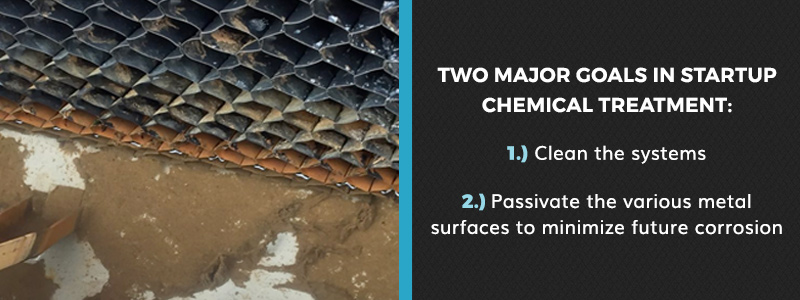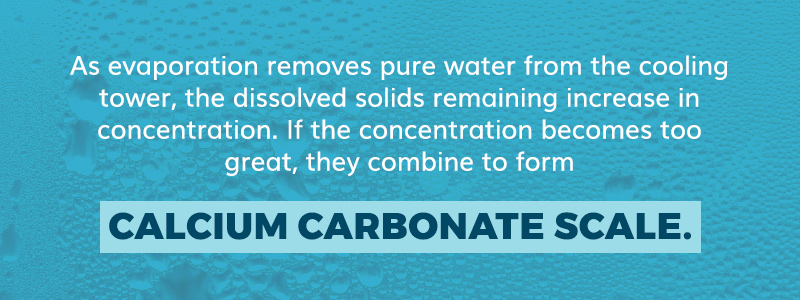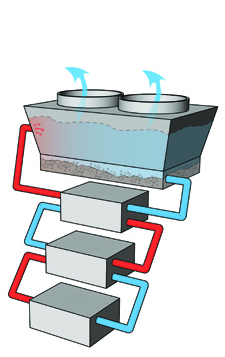The startup of a new cooling system is a critical period in its lifecycle. Chardon Labs offers cooling tower treatment for new systems with two clear objectives in mind: thorough cleaning and proper passivation.

During the equipment cleaning phase, we use cooling tower chemical treatment products that will remove in-transit oxidation, clean out corrosion by-products and eliminate oils and grease from manufacturer preparations. The goal is to ensure all system components are thoroughly flushed to prevent contamination.
Upon completion of the cleaning phase, the next step is passivation, which is a process designed to render component surfaces unreactive through the application of chemicals. There are different passivates designed for different cooling tower systems. Your Chardon Labs technician has the expertise to recommend a cooling tower chemical treatment for your needs.
The startup of a new system is an important time in the life cycle of a system. Chardon Laboratories understands that it is vitally important to properly clean and passivate the systems to ensure excellent protection, long life, and proper operation of the equipment.
The procedures themselves are straightforward, the challenge comes from the ability to implement them at the proper time and the proper order. New construction sites have many different demands and timetables than a far simpler equipment upgrade job. Depending on the site timetable loops may start before condenser systems, condenser systems may start without chillers in place yet, systems may start up, then sit idly afterward for periods of time until actually running with load, different manufacturers may have different recommended procedures or none at all.
Chardon is able to address these issues and make overall recommendations to properly passivate and protect systems under these varying conditions.
Chardon has two major goals in startup chemical treatment. The first is to clean the systems. The metals in the components develop corrosion by-products during shipping and installation. Despite the manufacturers best efforts to protect the components during this time period, some oxidation and corrosion occur. Some of the protection methods actually introduce materials that need to be removed before operation.
A specific example would be the oil coating on new steel pipe. Debris is also introduced into the components during actual construction. The second goal is to passivate the various metal surfaces to minimize future corrosion. Let’s look at each of these in further detail.
Chardon’s first step is to clean the equipment. We add chemical products to the system that are designed to remove in transit oxidation, clean out corrosion by-products, and clean out oils and grease from manufacturer preparations. We also add biocides that will kill any micro-organisms that may be in the components already.
During this phase, the systems are filled with water and then circulated with water and the chemicals through the entire system for at least 48 hours to ensure a thorough cleaning of all components. At the end of that time, the system needs to be thoroughly flushed until the water in the system is clean. The best method is to open low point drains throughout the system to flush any heavy debris out, then leave open low point drains sufficient to purge the system without overrunning the makeup capability of the system.
The system pumps should be left running at this point to circulate water through the system yet. It is best to flush the system in this manner to get a good removal of all debris. When the system has turned over approximately five times the volume and the water tests out clean any start up strainers should then be removed and cooling towers should be drained and washed out.
The key to all of this is to make sure that ALL the system components get flushed. If this is not possible due to timetable constraints, then the equipment that does not receive a flush must be flushed separately prior to coming online to prevent possible contamination of already cleaned components.
The next step is passivation. Condenser water components are already passivated from the cleaning chemical, with the possible exception of the tower. There are different treatments for different systems, and your Chardon Representative will help to determine a good choice for you. The important thing is to add them in right away, and circulate them throughout the entire system. The sooner they go in after flushing the better.
Cooling towers may require additional special chemical treatment for a longer period if they have galvanized components. The galvanizing requires extended passivation to prevent the formation of white rust.
These components are cleaned and passivated at the same time by the addition of Chardon’s recommended chemicals and biocides. As mentioned before, they should be circulated for at least 48 hours, then flushed. Again, it is critical to make sure that ALL the components get this treatment.
Open all valves and zones to ensure complete circulation. Any and all chillers, towers, pumps and piping need to have circulation through them. If for some reason, not all components can be flushed at this time, they should be flushed separately before being put online. The towers should be drained and washed out after the flush, and start up strainers removed. The flush is done when phosphate and iron levels in the water approach 0.3 ppm or less and the conductivity of the flush water equals that of the make-up water.
If the towers have galvanized components, the necessary treatment must be in place to begin treating for white rust upon completion of the flush.
A cooling tower’s heat exchanger allows heat to flow through a material, usually a stainless steel plate or copper tube, from the hot side to the cool side. Scale, typically in the form of calcium carbonate, can accumulate on the surface of the exchanger and act as an insulator that reduces its efficiency.

Chardon has a variety of water treatment chemicals to clean heat exchangers effectively. We use advanced chemistry for the most effective cleaning. Corrosion inhibitors and dispersants ensure the metal is protected and post-cleaning fouling does not occur. Your Chardon Labs technician can also apply additional products for certain heat exchanger cleaning applications as needed.

Water is carried from the condenser to the cooling tower, where it’s surface area is increased to facilitate evaporation. Some of the water is lost in the atmosphere, but the solids remain behind. When the cooled water reaches the sump, it is circulated back through the condenser, where it removes heat from the refrigerant.
The refrigerant is continuously cycled through the refrigerant loop. It absorbs heat from the chilled loop and is changed from a liquid to a gas in the evaporator. The compressor increases the pressure and temperature of the gas, which flows into the heat exchanger. There, the cooling tower water removes heat from the refrigerant causing it to condense back to a liquid.
The chilled loop is actually a closed loop where water is circulated throughout the entire facility continuously to fulfill the cooling requirements of the system.